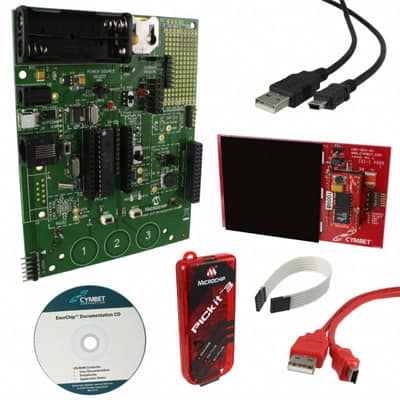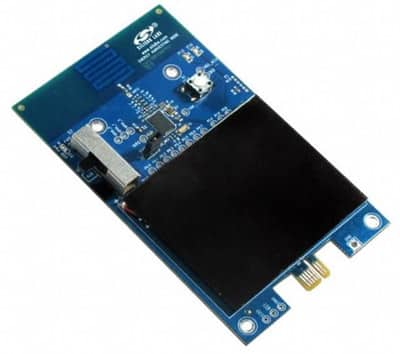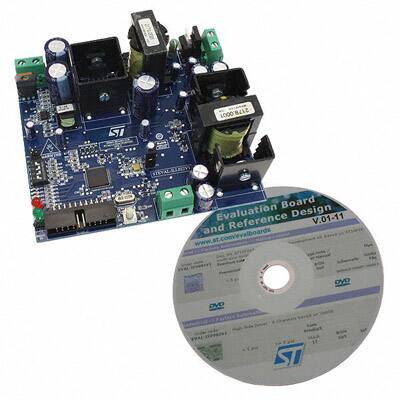Smart Lighting in the Enterprise
投稿人:DigiKey 欧洲编辑
2012-06-13
Daylight harvesting is becoming increasingly important in the design and implementation of commercial lighting systems. Being able to integrate the natural light from windows with flexible, controllable sources of lighting helps improve the work environment and cut energy bills.
Being able to have closer control of the lighting systems in a commercial environment is a key element to this strategy and energy harvesting can play an important role. Being able to have flexible placement of control pads for a commercial lighting system is an important requirement as office space is regularly reconfigured as existing clients grow and change their requirements and new clients have new requirements.
Daylight harvesting is a philosophy for designing the lighting system around the natural lights from the windows but also using the appropriate light in the right area, from halogen spotlights to lighted dark corners and fluorescent lights for wide open areas, to low energy LED bulbs around work areas. All of these can be controlled by a network of sensors and wireless links, directed either locally by control pads or from a central application that can be linked into the corporate network. This control network can also include the outdoor lighting, providing security and safety for workers at night while minimizing the cost of running them.
Harvesting energy from the environment to power control pads with sensors and wireless links to the lighting system can provide ultimate flexibility to place the pads exactly where they will be used most effectively. This allows office designers and facilities managers to provide the most effective and ergonomic environment, improving the quality of light in the office at the same time as reducing costs.
Using energy harvesting also eliminates the need to replace batteries in the control pads, which, with more and more pads being used, can be an expensive activity. Of course the lights are mostly powered by the mains but the reduction of the power consumption of microcontrollers and wireless transceivers from the latest process technology brings the energy requirements of the connected control pad down to the point where the power can be provided from the environment.
For indoor lighting, the main source of energy for the pads is the lighting system itself. That may seem strange, but a solar energy harvesting system can collect the light and store the energy in a battery for use when it is dark, keeping a system running for years without light available.
The latest developments in silicon technology also provide more flexible and efficient solar cells as well as making existing technologies more cost effective. This gives the designer of the control pad more options for providing power to the system through cells with larger area or smaller ones with more efficiency. This depends on the space available, the look of the units, and the typical use cases. Some control pads may have small displays that may need to be powered, others may use a simple LED just to indicate a switch has been used. More control pads are making more use of capacitive sensors which also need to be powered.
Solar cells
The Sanyo AM-5902CAR uses a flexible solar cell material based on amorphous rather than crystalline silicon to give the designer more options.
Amorphous silicon has irregular atomic arrangements that allow much more light to be absorbed, making the cell thinner for a given power output. This means film of less than 1 µm can be produced and used for power generation. By using a plastic substrate, this film can be made flexible to use for harvesting the light energy to power the controller pad.
However, other solar cell technologies can be used. IXYS’ IXOLAR SolarMD can be used to power the wireless sensors and backup batteries in the pad. With a cell efficiency of typically 22 percent, SolarMD gives the ability to extend run time even in "low light" conditions and increase battery life and run time in a small footprint, which can be easily accommodated in the design of portable products. The design allows connecting SolarMD flexibly in series and/or parallel to meet specific power requirements.
Clare uses a monolithic photovoltaic string of solar cells with switching circuitry. When operating in sunlight or a bright artificial light environment, the light energy activates the CPC1822 and generates a voltage at the output. These cells are capable of generating a floating source voltage and current sufficient to drive and power CMOS ICs, logic gates, or provide the trickle charge for a battery for the wireless network in the control pad.
Wireless
Microchip’s XLP 16bit Energy Harvesting Development Kit uses solar energy as the basis of a modular development platform that can be used to develop control systems for commercial lighting. Using Microchip’s PIC MCUs with nanoWatt XLP technology, the system can run effectively from the small amounts of power available from the solar cell to power an RF transceiver through the expansion connector for PICtail modules.

Figure 1: Microchip’s XLP energy harvesting development kit.
The kit is developed in conjunction with Cymbet using its Solar Energy Harvester. This uses a high-efficiency solar panel suitable for use with indoor light that captures, manages, and stores energy in two Cymbet EnerChip thin-film rechargeable energy storage devices. The EnerChips supply energy to the XLP development board when light is not available.
The power condition and capacity are monitored by the PIC24F microcontroller using Energy Conscious software algorithms developed by Microchip and Cymbet and so integrated into a control pad.
Silicon Labs also has a Solar Energy Harvesting Board with Thin Film Battery that has all the elements to provide a networked node that is powered from indoor lighting of around 200 lux. This evaluation board is ideal for commercial lighting control pads as it is aimed at systems that wake periodically to measure and transmit results. As it is powered from an energy harvesting source, the life expectancy of the thin film battery is greater than 15 years or 7000 mAh. This also means the wireless node can be designed with a very thin profile as the battery height is 0.17 mm to fit into a small casing suitable for a control pad that can be easily mounted anywhere in the office environment.

Figure 2: Silicon Labs’ solar energy harvesting kit with thin film battery.
The system consists of two components: a wireless sensor node and an EZRadioPRO USB Dongle. The sensor node uses a Silicon Labs Si1012 wireless MCU while the dongle uses an 8051 microcontroller and Silicon Labs Si4431 radio operating at 919.84 MHz, powered by a solar energy harvesting power supply. When the wireless sensor node is not transmitting data, the MCU can remain in a low-power state where it only consumes 50 nA. The leakage current of the energy harvesting supply is approximately 3 µA and is cancelled out by as little as 50 lux shining into the solar cell. This allows the energy harvesting supply to power the system for approximately seven days in a dark closet or indefinitely if there is a periodic light source that replenishes the lost energy.
The energy management comes from a solar cell that provides the DC energy and a Linear Technologies battery management IC which takes in DC energy and regulates it to a constant 4.1 V. This also protects the battery from over discharge (by disconnecting it from the circuit if its voltage gets too low) and provides a “ship mode” that disconnects the battery during shipping and allows it to hold its energy until the end user starts up the system.
The energy storage used in this reference design is a 4.1 V, 700 µA-H, thin film battery from IPS. This battery provides enough energy storage to keep the system running for many days without any “harvested” power.
The energy management circuitry at the output of the energy storage converts the 4.1 V thin film battery voltage to a regulated 2.7 V for use by the Si1012 Wireless MCU. The main components of this circuit are an ultra-low power LDO, a brownout detector, and a 100 µF tantalum capacitor to supply the peak currents required for RF transmission. The LDO’s shutdown pin is tied to the output of the brownout detector, so that the system is not powered until the 100 µF capacitor is charged up to at least 3.0 V. This ensures that the system will not attempt to power up unless it has enough stored energy to get it through the power up sequence.
Power
Maxim’s MAX17710 is a complete system for charging and protecting micropower-storage cells such as microenergy cells (MECs). The IC can manage poorly regulated sources such as energy harvesting devices with output levels ranging from 1 fW to 100 mW. The device also includes a boost regulator circuit for charging the cell from a source as low as 0.75 V.
An internal regulator protects the cell from overcharging while the output voltages supplied to the target applications are regulated using a low-dropout (LDO) linear regulator with selectable voltages of 3.3 V, 2.3 V, or 1.8 V. The output regulator operates in a selectable low-power or ultra-low-power mode to minimize drain of the cell. Internal voltage protection prevents the cell from over discharging.
The device controls two main functions in an energy-harvesting application: charging a low-capacity cell with overcharge protection and an LDO regulator output with over-discharge protection. With the exception of protection features, charging and regulation functions operate completely independently of one another.
Outdoor lighting
Energy harvesting can also be used for outside lighting as the main source, only moving to AC power when the battery runs down. This can considerably cut the energy bills for large commercial facilities that need to light outdoor areas such as car parks and walkways. The STEVAL-ILL022V1 solar-LED streetlight controller evaluation kit from STMicroelectronics (Figure 3) is made up of an 80 W battery charger and a 25 W LED driver.

Figure 3: STMicroelectronics’ LED streetlight controller evaluation kit.
When the sun is present, the charger converts the electricity from the solar panel then charges the battery. In a dark ambient where no sun is present, the battery powers on the LED lamp as a streetlight. When wet or cloudy weather persists for several days the battery gradually runs out of power. The controller then switches on the AC mains supply instead of the battery to power on the LED until the battery is fully charged again.
The kit supports Maximum Power Point Tracking (MPPT) to get the maximum possible power from the solar panel by sampling the output of the cells and applying the right load to get the maximum efficiency.
The kit also includes a self-adapting charger for a 12 V/24 V battery as well as automatic day/night/weather detection and automatic battery/mains switch over. A constant current control for LED lamps and battery charge control simplifies the system design and includes an easy system monitoring tool available via debug LED indicators.
The outdoor systems can also be linked to a wide area wireless network for more fine-grained control from a central controller and potentially link to security systems without incurring further power costs.
Conclusion
Energy harvesting for commercial lighting is in its infancy, but there is a wide range of approaches that can be used to both enhance the work environment and reduce energy bills. Using energy harvesting directly to charge batteries and power lighting is possible, but there are more opportunities to use the technology inside the enterprise. Being able to place control pads in any location without having to wire them into the mains power or regularly replace batteries provides the facilities manager or the office manager with tremendous flexibility. This also allows innovative new approaches to designing the lighting environment within the office to emerge. This daylight harvesting approach provides benefits for staff and at the same time helps to save on bills at a time when energy costs are growing and are a major consideration for many commercial operations.

免责声明:各个作者和/或论坛参与者在本网站发表的观点、看法和意见不代表 DigiKey 的观点、看法和意见,也不代表 DigiKey 官方政策。









 中国
中国